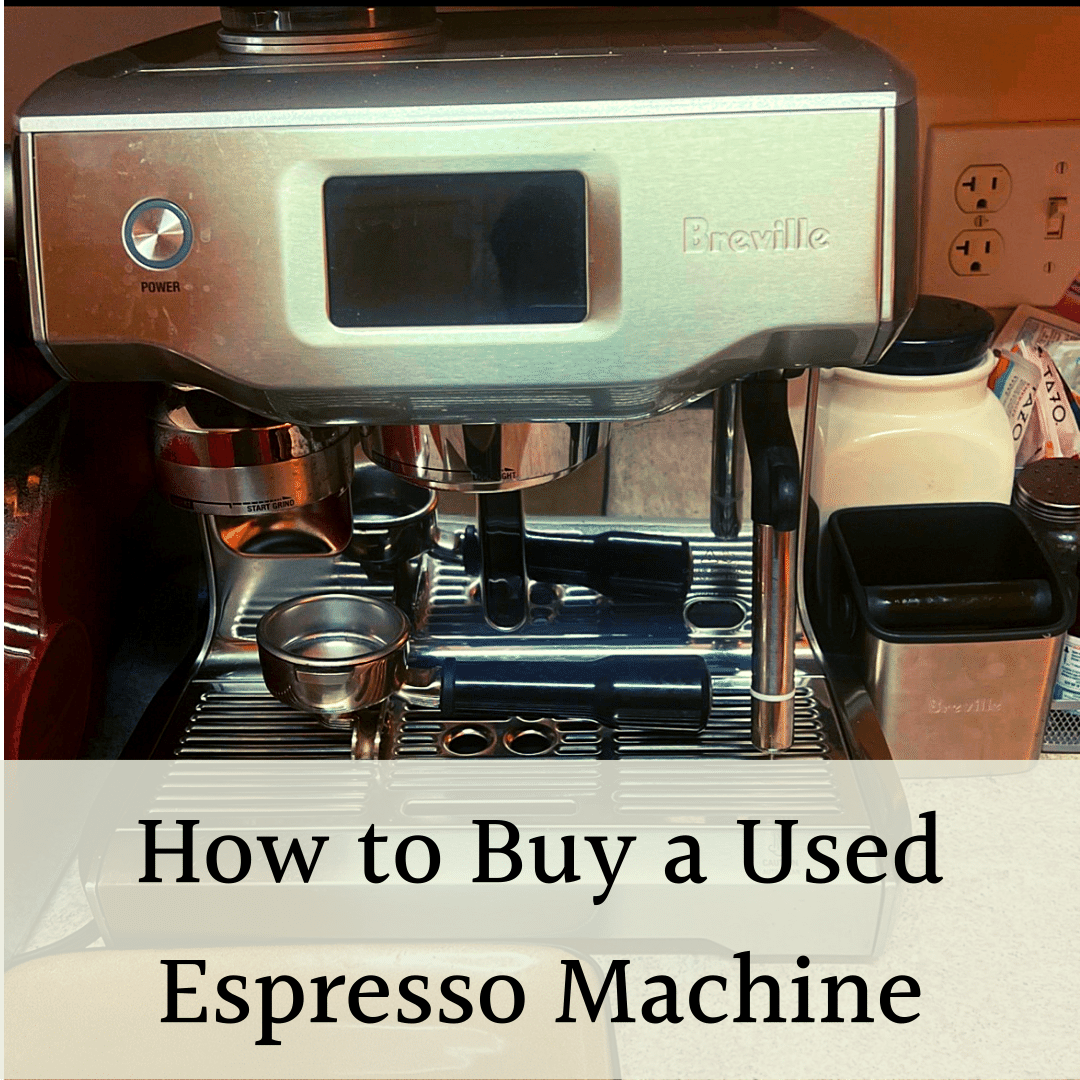In home espresso machines, two big names often come up: Breville and DeLonghi. These two household names have consistently delivered innovative and high-quality coffee machines.
Here’s what the Breville vs. DeLonghi difference boils down to: Breville focuses on semi-automatic machines (popular Bambino and Barista lines). DeLonghi excels on super-automatic machines (such as the Dinamica and Magnifica lines).
In this espresso machine comparison, I’ll delve deep into the heart of the Breville vs. DeLonghi showdown. I’ll dissect their espresso machine lines, design philosophies, tech innovations, and more to help you decide which manufacturer is best for your needs.
About Breville
Breville was founded in Sydney, Australia, in 1932 by Harry Norville and Bill O’Brien. They combined their last names, and Breville was born.
The brand started as a small radio manufacturer. Over the years, it emerged as a renowned maker of high-quality kitchen equipment, particularly espresso machines. They manufacture a wide range of machines, mostly targeting home espresso enthusiasts.
Breville espresso machines are known for their precision and convenience. Their lineup offers plenty of features, such as customizable grind settings, milk-frothing capabilities, and intuitive user interfaces.
Their coffee machines have an iconic, recognizable stainless steel exterior with sleek displays. The brand focuses on semi-automatic espresso machines, which provide a more hands-on experience for more control over your espresso.

Breville also has a wide range of espresso accessories to enhance your coffee-making experience. For example, every Breville includes a milk frother for lattes and cappuccinos. Others also have a built-in grinder, which is easier to use as an integrated model.
Finally, Breville has fewer coffee machines compared to DeLonghi. Their machines have a similar style — stainless steel semi-automatics. Choosing between them is a question of what particular features you want on your machine.
DeLonghi
DeLonghi is an Italian brand. DeLonghi started as a small workshop in Treviso, Italy, in 1974 and evolved into a global household name.

To this day, DeLonghi espresso machines are still manufactured in Italy, with user convenience in mind. This is why DeLonghi focuses on super-automatic machines, such as the popular Magnifica and Dedica.
DeLonghi machines also have features such as milk frothers, adjustable grind settings, and temperature controls to enhance the coffee-making experience.
The difference is that most DeLonghi espresso machines utilize these features in a programmable, hands-off way. For example, you can choose the brewing time and coffee strength from the machine display or buttons, and the machine will take care of the rest for you. This reflects the difference between super-automatic and semi-automatic machines.
Finally, DeLonghi has a diverse range of budget options that are small and take up limited counter space.
Comparing The LineUp of Each Manufacturer
The Breville espresso machine lineup focuses on semi-automatic machines. That means for every model, you’ll have to load and attach a portafilter to an espresso machine. This involves some more work as portafilter preparation is important in getting a good espresso.
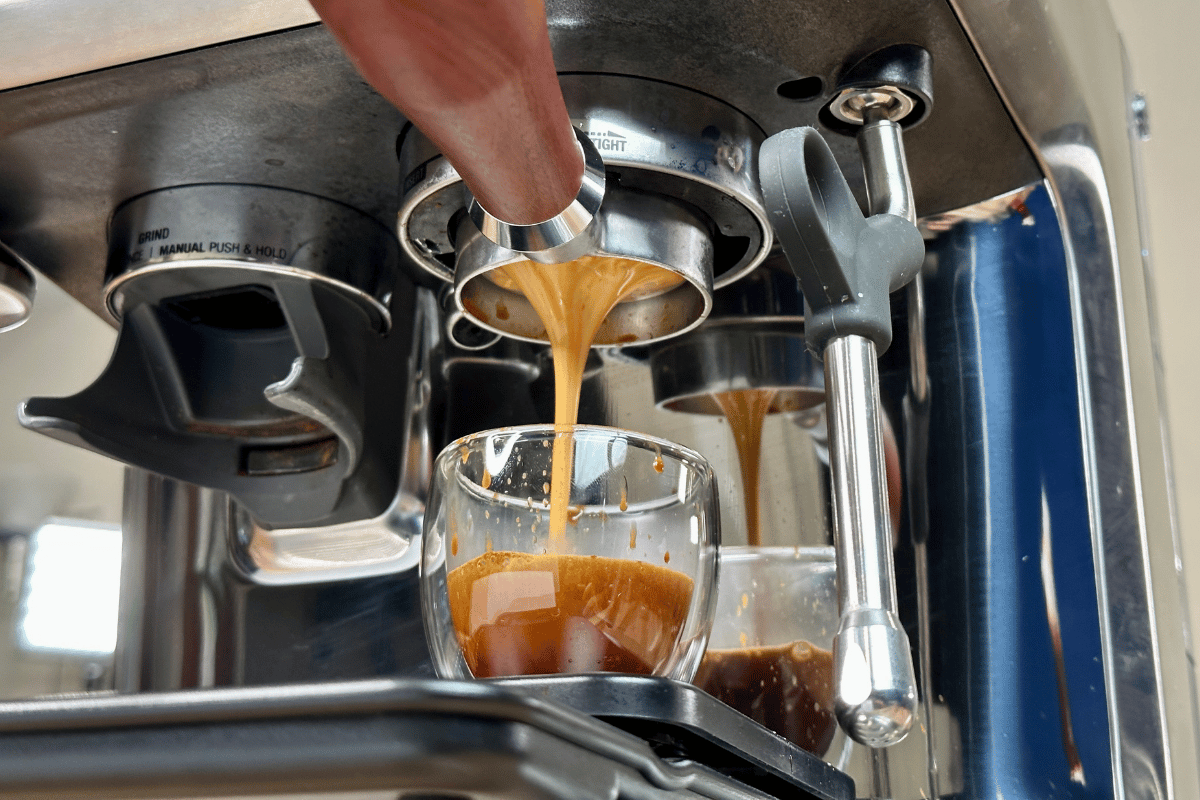
That being said, Breville models have different levels of user convenience that make it much easier. Their Barista models include integrated grinders, so the coffee falls right into the portafilter. One step further, the Impress series will also tamp the coffee and measure the dose level.

On the high end, the Oracle automates each step of the puck prep and brewing process. You only have to move the portafilter between the grinder and brew head. This series is at the crossroads between a semi and a full-automatic espresso machine.
Overall, the differences between various Breville models are mostly a matter of what features you want. For example, with or without a grinder, buttons or displays, and manual or automatic milk frothing.
DeLonghi focuses more on super-automatic machines. These models really just require you to add beans and push a button. The Magnifica and Dinamica are true fully automatic machines. These machines handle the entire espresso-making process. They do everything from grinding the beans to brewing with minimal user intervention. All you need to do is add whole coffee beans.
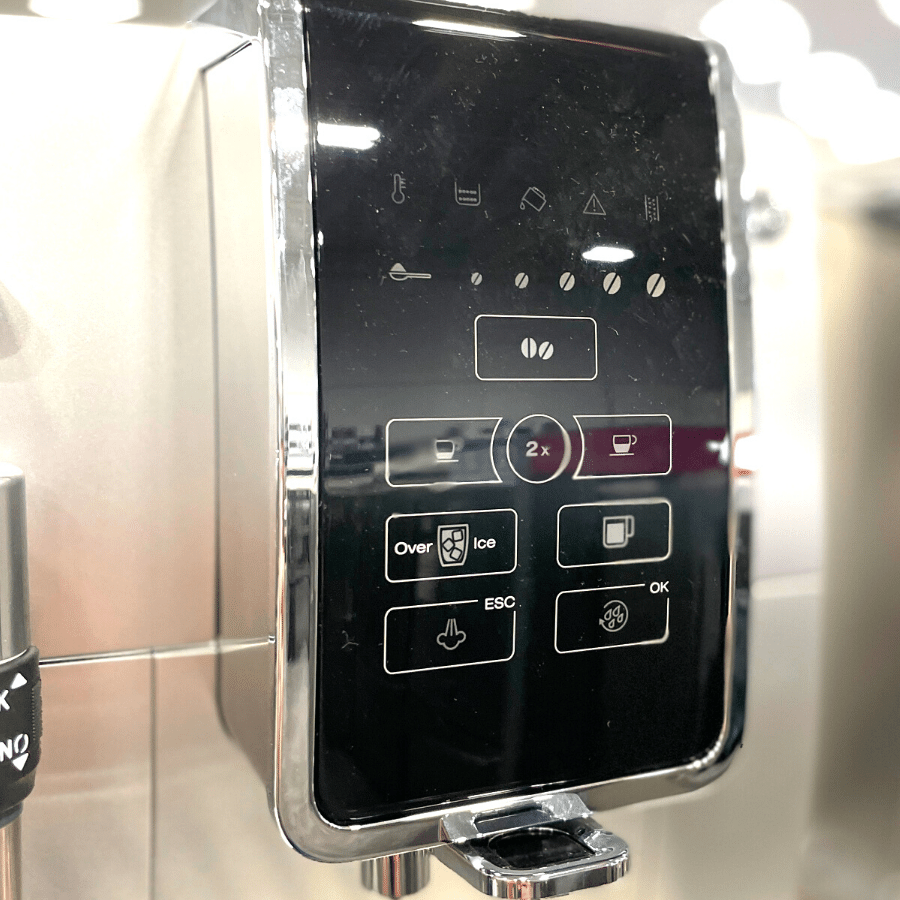
That being said, DeLonghi also has plenty of semi-automatic options. One example is the La Specialista, which gives a balance between manual control and automation.
Finally, both companies offer Nespresso machines. These models can only be used with Nespresso pods. In this case, both Breville and DeLonghi use Nespresso’s patented technology to brew coffee. The main difference is in the external machine design and user interface.
Semi-Automatic Model Comparison
Semi-automatic espresso machines offer a perfect balance between control and convenience. Breville wins in the semi-automatic department. From entry-level Bambino to the high-end Oracle, Breville has a vast range of semi-automatic machines for you to choose from.
Here’s a summary of Breville’s semi-automatic coffee machines.
Bambino Series
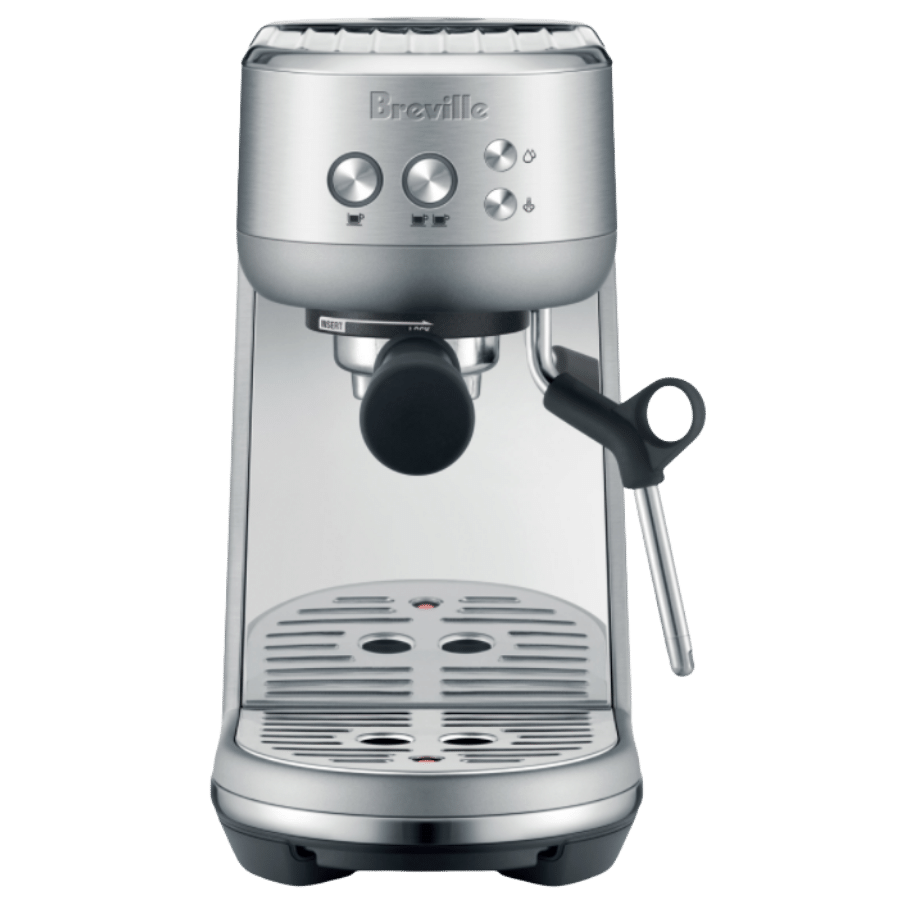
Bambino highlights:
- Manual steam wand; 360 rotation
- Thermojet system (3-second heat up)
- Simple presets and easy-to-clean drip tray
Bambino is Breville’s entry-level semi-automatic machine. These compact machines are designed for simplicity and ease of use. This is why they are an excellent choice for beginners. Despite their compact size, they deliver impressive espresso quality. They also come equipped with milk frothers for lattes and cappuccinos.
You can choose between the Bambino and the Bambino Plus, which we’ve reviewed. The main difference between them is the automatic milk frothing and more automated options on the Plus. These are also the most compact coffee machines Breville has.
Barista Series
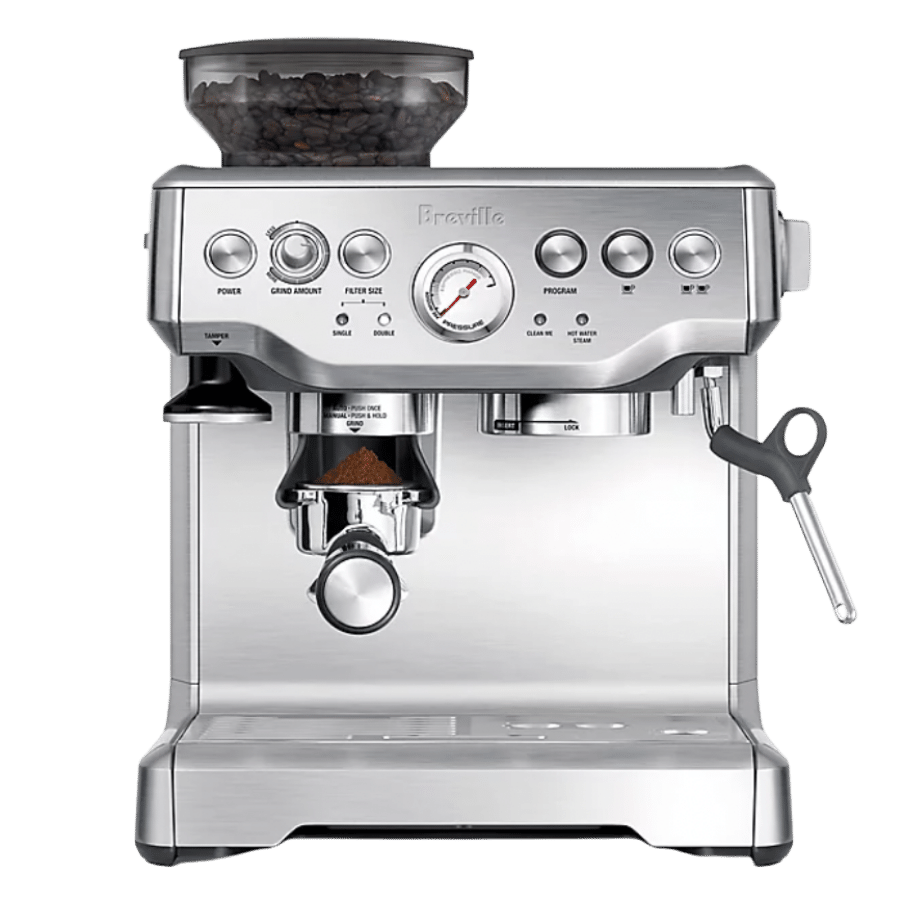
Breville Barista Express highlights:
- Conical burr coffee grinder with 16 settings
- Thermocoil heating system
- 67 oz water tank
The Barista series stands out with its built-in, conical burr grinders. You’ll have freshly ground beans for your espresso. Other features include customizable grind settings, precise dose control, and manual milk frothing capabilities. Overall, these machines offer a high level of control over your coffee-making process.
One of the most popular models is the Breville Barista Express. It’s been a coffee lover’s favorite machine for over a decade. Its built-in grinder, steam wand, and a digital temperature control system give you control over each step of the brewing process. Breville Barista Express is a popular starter espresso machine, as it gives you the hands-on experience needed to learn all about espresso making and grow your skills.
The Barista Series also includes the Barista Pro, which has a very similar design to the Express. However, it comes with an updated Thermojet heating system, digital display, and almost twice as many grind settings.
Finally, Breville recently came out with the Barista Express Impress. Don’t let the name confuse you. It’s basically an upgraded version of the original Barista Express. The main difference is that Express Impress has automated tamping. This means the machine grinds and tamps coffee grounds. There’s less mess and less work for you.
Let’s move on to the DeLonghi semi-automatics.
La Specialista Series
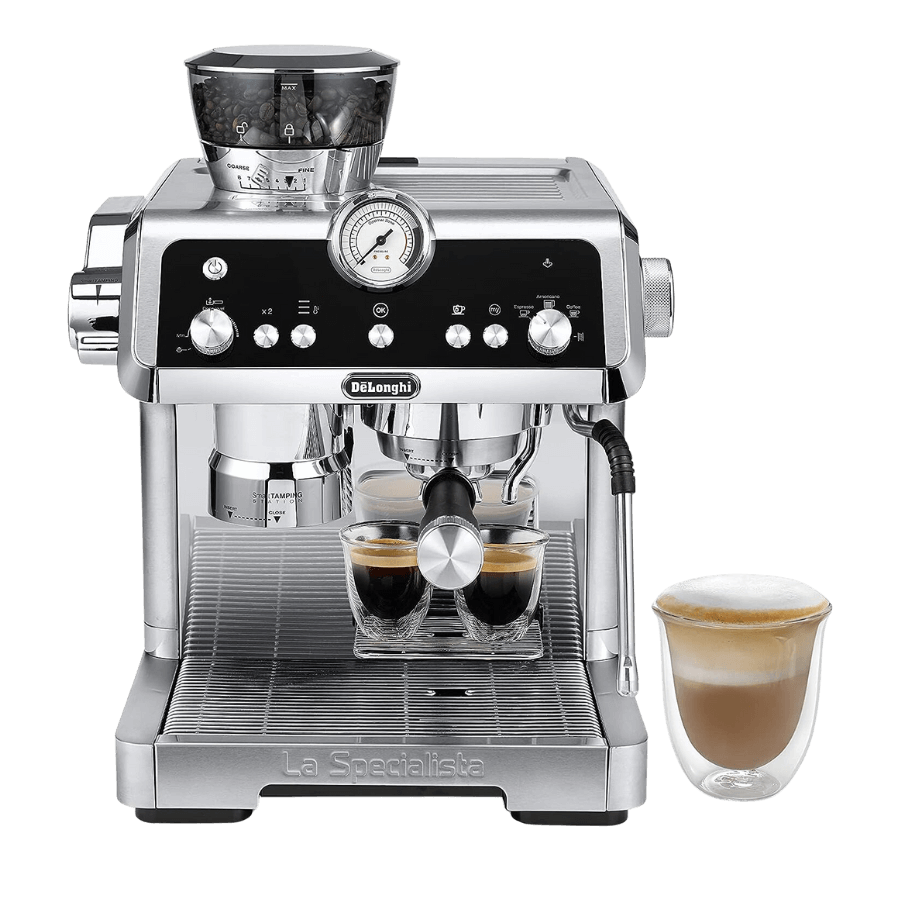
DeLonghi La Specialista Prestigio highlights:
- Dual heating system
- Sensor grinding technology
- Smart tamping
DeLonghi recently redesigned its La Specialista series. Now, you can choose between the La Specialista Arte, Arte Evo, Prestigio, and Maestro.
The La Specialista Arte is the most affordable in the lineup. This is the only true semi-automatic model because it’s the only La Specialista machine that doesn’t have automatic tamping. As you move to the La Specislita Prestigio
Overall, the updated La Specialista machines offer a well-balanced combination of manual and automated features. With a built-in grinder, sensor grinding technology, precise temperature control, and an advanced tamping system, it’s a significant step up from its predecessors.
Dedica Arte
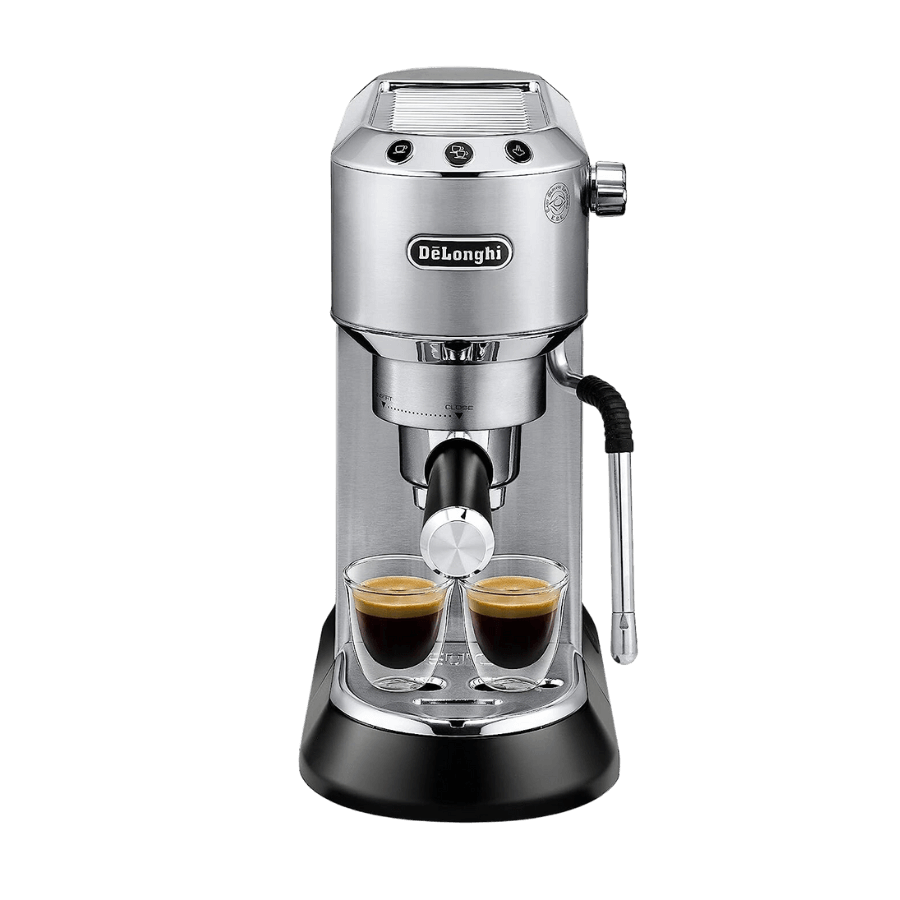
Dedica Arte highlights:
- 15-Bar Professional Pressure
- My LatteArt Steam Wand
- Accommodate Taller Cups
Dedica Arte is another solid semi-automatic from DeLonghi. It caters to those seeking a sleek and compact semi-automatic machine. In fact, it’s DeLonghi’s slimmest machine DeLonghi and compares directly to the Bambino line.
The water tank pays the price for the compact size (it’s only 35 oz), and the Dedica Arte doesn’t include a grinder. Still, the machine offers a solid espresso-making experience.
There are also several Dedica options, including the Dedica Original and Dedica Deluxe. The difference is these models come with no-frills steam wands that aren’t as powerful as the Arte.
Summary
Ultimately, the choice between Breville and DeLonghi in the semi-automatic category will depend on your specific preferences and the level of control you want over your espresso-making process. Breville offers more options, including high-end models like the Oracle. DeLonghi’s revamped La Specialista is a solid choice if you want to balance automation and manual control.
Super Automatic Lineup Comparison
DeLonghi is better known for their super-automatic or bean-to-cup espresso machines. Let’s get into them.
Dinamica Series

DeLonghi Dinamica highlights:
- Integrated steel burr grinder with 13 settings
- Stainless steel boiling system
- 15 bar pressure pump
The DeLonghi Dinamica machines are designed for coffee enthusiasts seeking the utmost convenience. They have a one-touch brewing experience for various coffee beverages. You can customize coffee strength, milk froth, and temperature settings, and the machine does all the work for you.
You can choose between the Dinamica base model and Dinamica Plus. What makes the Dinamica series stand out is the patented TrueBrew Over Ice technology. These machines can make iced coffee as conveniently as they brew hot coffee. I can confirm the results are rich and flavorful.
The main difference between the Dinamica and the Dinamica Plus is that the Plus has five default recipes and app compatibility, which lets you make coffee from wherever you are via a mobile app.
Magnifica Series

Magnifica Evo highlights:
- 6 One-Touch Recipes
- Built-in Conical Burr Grinder with 13 settings
- Traditional milk frother
The DeLonghi Magnifica series is known for its compact, super-automatic espresso machines. These models are designed for users with limited countertop space. They are great if you want one-touch espresso brewing that can fit almost anywhere.
You can choose between Magnifica Start, Magnifica Evo, and Evo Titan DeLonghi machines. The Start espresso machine has three coffee recipes and automatic milk frothing. The further you go, the more recipes — the Evo has four, and the Evo Titan has seven. Also, the Evo Titan is the most automatic model, as it has automatic milk frothing.
Let’s move on to Breville super automatics. Even though Breville isn’t traditionally known for super automatics, it has a few models with advanced automation features.
Oracle Series

Breville Oracle Touch highlights:
- Technically semi-automatic with automatic tamping
- Grinder with 45 settings
- Automatic milk frother cleaning
Oracle series isn’t a traditional super-automatic as you still have to move the portafilter. This is more than pushing a button, but still, we’ll call this a super, since it offers a high level of automation and customization.
These machines feature automatic grinding, tamping, brewing, milk texturing, and precise temperature control. However, it’s not a one-touch brewer. You still have to move the portafilter to the grinder and tamper, then into the grouphead, and then press the brewing button manually. It’s a nice balance between full automation and hands-on brewing.
Impress Models
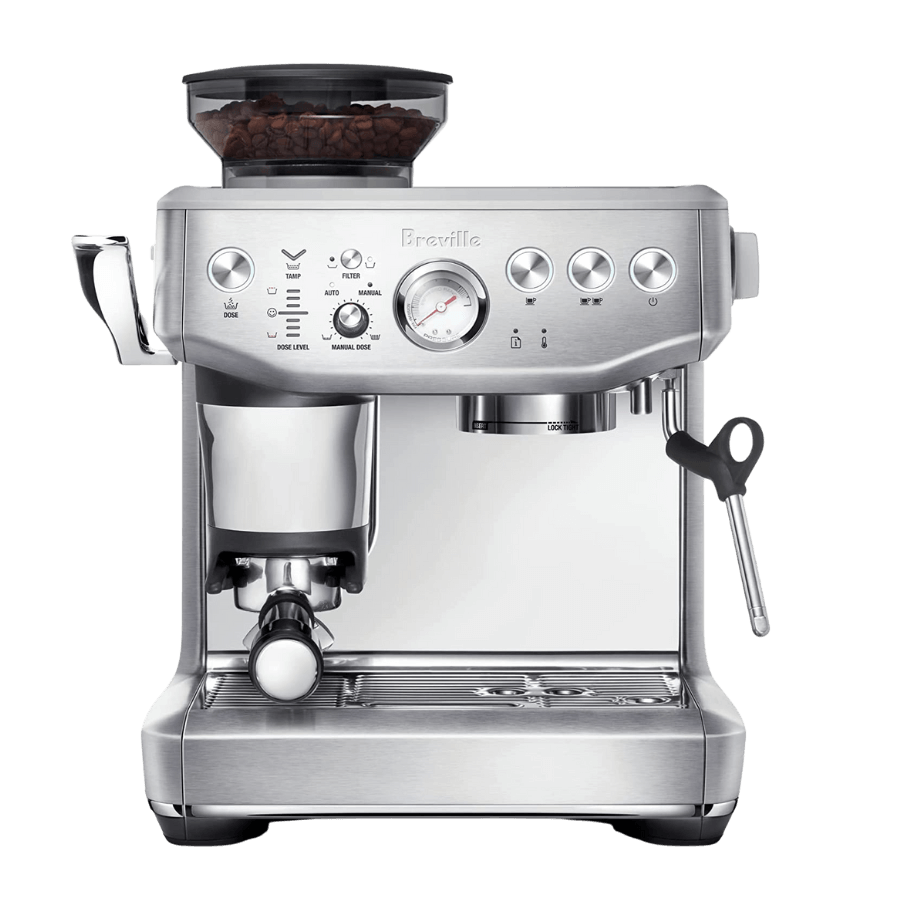
Breville Barista Express Impress highlights:
- Thermocoil: 30-second heat up
- One-hole steam wand (less powerful)
- Assisted dose and tamping make puck pre much easier.
The Impress machine isn’t super-automatic in the traditional sense. However, it simplifies the espresso-making process by automating tamping. This is a critical step in espresso preparation as it determines the brew quality. A bad tamp is a quick way to ruin an espresso shot, so automating this step provides great consistency for espresso beginners.
Summary
In summary, DeLonghi offers a range of super-automatic espresso machines for various preferences. You can choose from compact options to highly customizable models. Breville doesn’t traditionally offer super automatics. But it has options like the Oracle series and Impress models. These offer advanced automation features and strike a balance between control and convenience.
Breville vs. DeLonghi Nespresso Machines
Both Breville and DeLonghi manufacture Nespresso machines. Most importantly, you’ll get the same coffee quality with both manufacturers. They use Nespresso extraction technologies and the same pods.
The main difference is in the coffee machine’s visual design. Most Breville Nespresso machines have more rounded tops. On the other hand, DeLonghi ones have sharper edges. DeLonghi also has more color options.

Also, most Breville and DeLonghi Nespresso machines only create coffee drinks — no milk options. The exceptions are the Lattissima and Creatista Series.
Breville Creatista
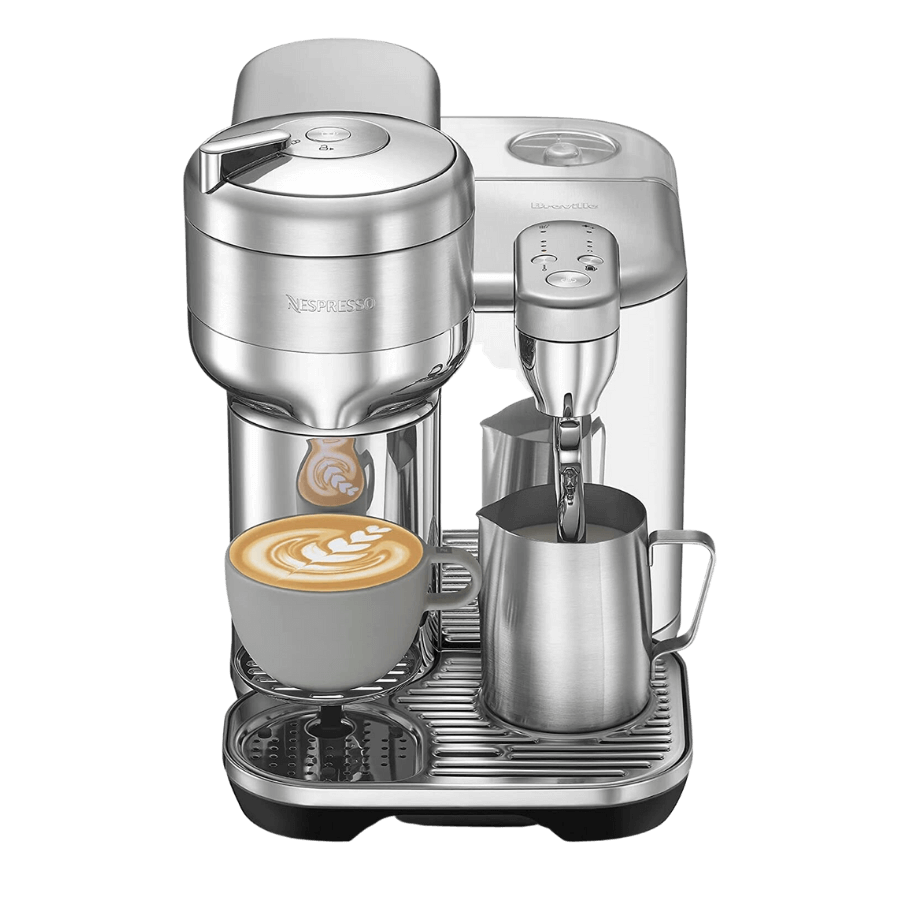
Breville Nespresso Vertuo Creatista highlights:
- Centrifusion brewing technology
- Compatible with Vertuo pods
- Hands-free milk frothing with three temperature and texture settings
Breville Creatista Line is made up of the Creatista Uno, Creatista Plus, and the Creatista Pro. Each of these has a recognizable Breville stainless steel finish and an automatic steam wand. All of them use OriginalLine Nespresso pods.
Breville also recently came out with the Creatista Vertuo machine. This is the only Nespresso machine that uses VertuoLine pods and can steam milk.
Note: I won’t go into the differences between each model here. You can read our Creatista Plus review, where we also talk about the differences between the models.
DeLonghi Lattissima
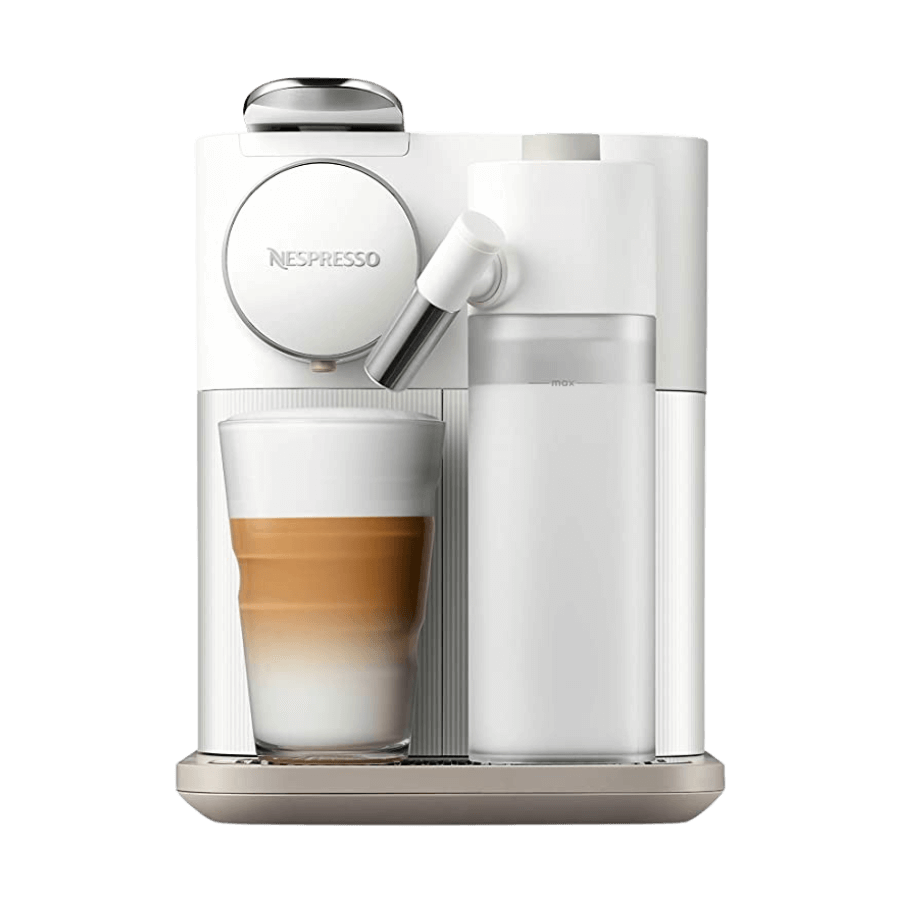
Gran Lattissima highlights:
- OriginalLine device
- Brews 9 coffee drinks
- Rapid Cappuccino milk system
DeLonghi Lattissima is DeLonghi’s Line of Nespresso machines. It’s made up of the Lattissima One, Lattissima Touch, Lattissima Pro, and Gran Lattissima. Each of these DeLonghi machines uses OriginalLine pods and a milk container to make drinks. The main difference compared to the Creatista models is the steam wand. Latissima machines use a milk container that dispenses foam, while Creatista models have a steam wand that you can use to steam milk yourself.
How Features Differ On Breville Vs. DeLonghi
Espresso Brewing
Generally, you can brew quality espresso shots that are rich, robust, and flavorful with both Breville and DeLonghi machines. While there’s not a huge difference between the espresso quality, I give a slight advantage to Breville espresso machines.
Breville tends to focus more on the espresso quality than ease of use. I could pull flavorful shots with every Breville machine I used. This wasn’t always the case with DeLonghi (I’m looking at you La Specialista Prestigio).
As mentioned, Breville makes semi-automatic machines, such as the Barista Express and Bambino series. These machines provide a high level of control over the brewing process. You can adjust grind size, dose, and shot time, and you can steam your own milk.
Both machines use a thermoblock heating system, which heats water quickly through a heated block with metal piping. This is common on entry-level machines. Since both manufacturers use the same heating system, which make similar espresso quality. However, Breville has recently redesigned their thermocoil as the ThermoJet, which can heat in 3 seconds. It’s a very fast start-up time and has better temperature stability, which edges out other models.
Both manufacturers use PID sensors, pre-infusion, and 15 or 19-bar pressure pumps. These are all needed for proper espresso extraction, and similar core components mean you’ll get good espresso from either one.
One difference is the portafilter size. Breville uses a 54mm portafilter diameter, while DeLonghi uses a 51mm portafilter. I prefer the wider portafilter, as it means there’s a wider surface area for water to move through.
You can get an idea from our infographic:
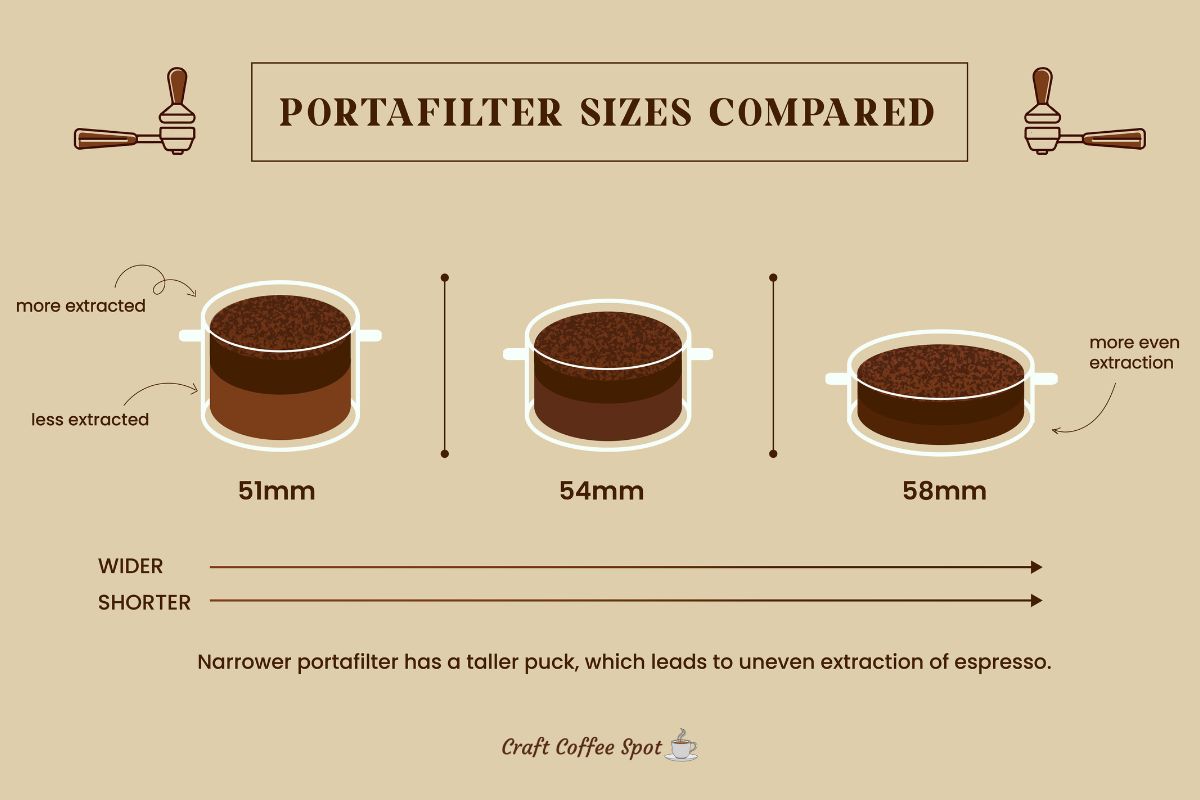
This improves espresso quality, although the differences are debatable. Just note that each one will have accessories matching the portafilter size.
Design
Breville is known for its classic and elegant design aesthetic. Their machines always feature a complete stainless steel construction and a timeless feel.
DeLonghi’s design philosophy varies across its models. Some, like the Dedica Arte series, are compact and sleek, catering to users with limited space. Others, like the Magnifica and Dinamica series, offer more sophisticated and modern designs. DeLonghi’s design approach varies with the specific characteristics of each machine.
Most DeLonghi coffee machines, especially the super-automatic series, have touchscreens you use to work the machine. The exception is the La Specialista series, which has a more traditional espresso machine feel with a pressure gauge and buttons that feel much like a Breville machine.
With Breville machines, touchscreens are the exception. Most semi-automatic machines are button-operated, but more automated machines use touchscreens to control brewing. For example, the Touch and Oracle only have a start button and touchscreen display, while the Express series only has buttons without displays. The rule with Breville is the more automated espresso machine, the fewer buttons.
Ease of Use
DeLonghi espresso machines are easier to use because they are more automated. These machines are designed to handle almost every aspect of coffee preparation with minimal intervention from you.
For example, DeLonghi’s super automatics have one-touch brewing. You simply select your desired drink, and the machine takes care of the rest, including grinding, brewing, and milk frothing.
That being said, Breville endeavors to make its models generally easy to use. Breville’s semi-automatic machines give a balance between control and ease of use. They are designed with user-friendly interfaces, intuitive controls, and clear displays, which makes it simple for users to operate them even without much espresso experience.
Also, Breville developed semi-automatics that incorporate automation features without compromising on control. For example, the Express Impress has automatic puck creation that includes grinding and tamping.
Some Breville models come with built-in tutorials or guides, which are especially helpful for beginners. These tutorials walk you through the coffee-making process, from grinding to brewing, ensuring a smooth learning curve.
Both manufacturers also use user-friendly design features, like simple button layouts, accessible water tanks, and intuitive controls.
Milk Frothing
The milk frothing capabilities of espresso machines vary depending on whether they are semi-automatic or super-automatic models.
Breville’s semi-automatic machines, like the Barista Express and Bambino series, feature steam wands for manual milk frothing. These steam wands let you froth milk to your desired texture and temperature. You have full control over the frothing process.

You can also find models, like the Bambino Plus, Touch, or Oracle, with automatic milk frothing. Breville uses a temperature sensor in the drip tray to automatically start and stop frothing.
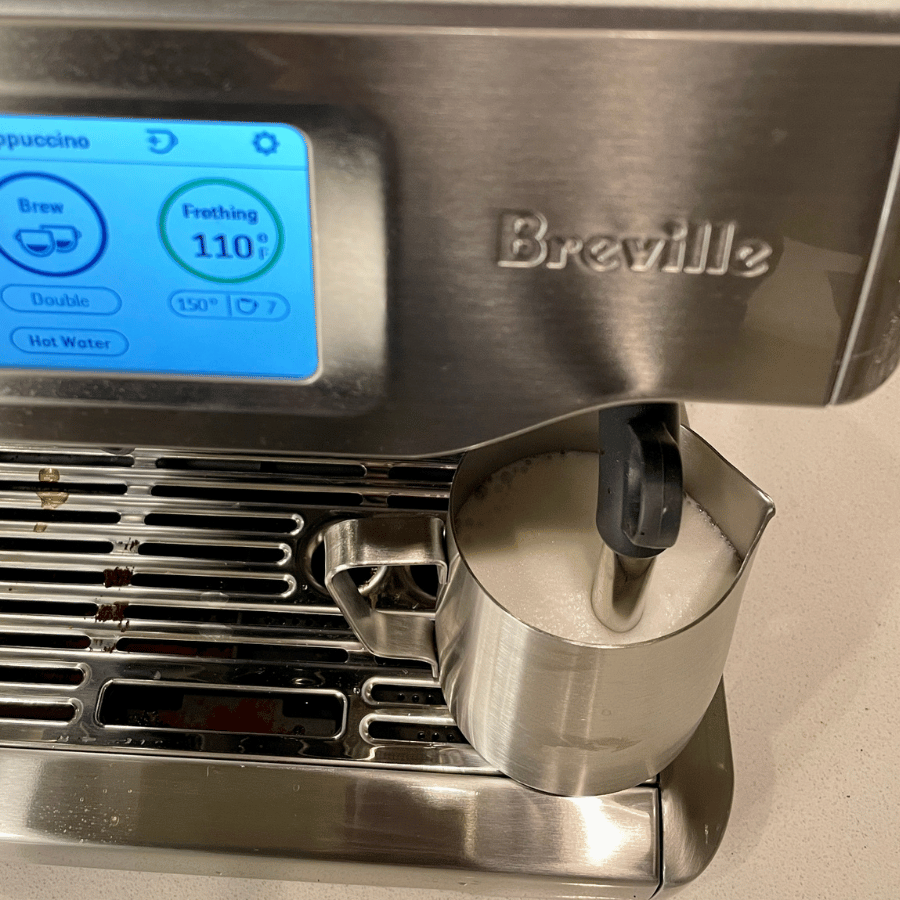
DeLonghi’s semi-automatic models, such as the La Specialista and Dedica Arte, also have steam wands for manual milk frothing. These models are very comparable to Breville with professional steam wands. However, some DeLonghi semi-automatic come with a Pannarello wand, which isn’t as powerful as the wands on the Breville models. This includes the ECP series, original DeLonghi Dedica, and Dinamica.
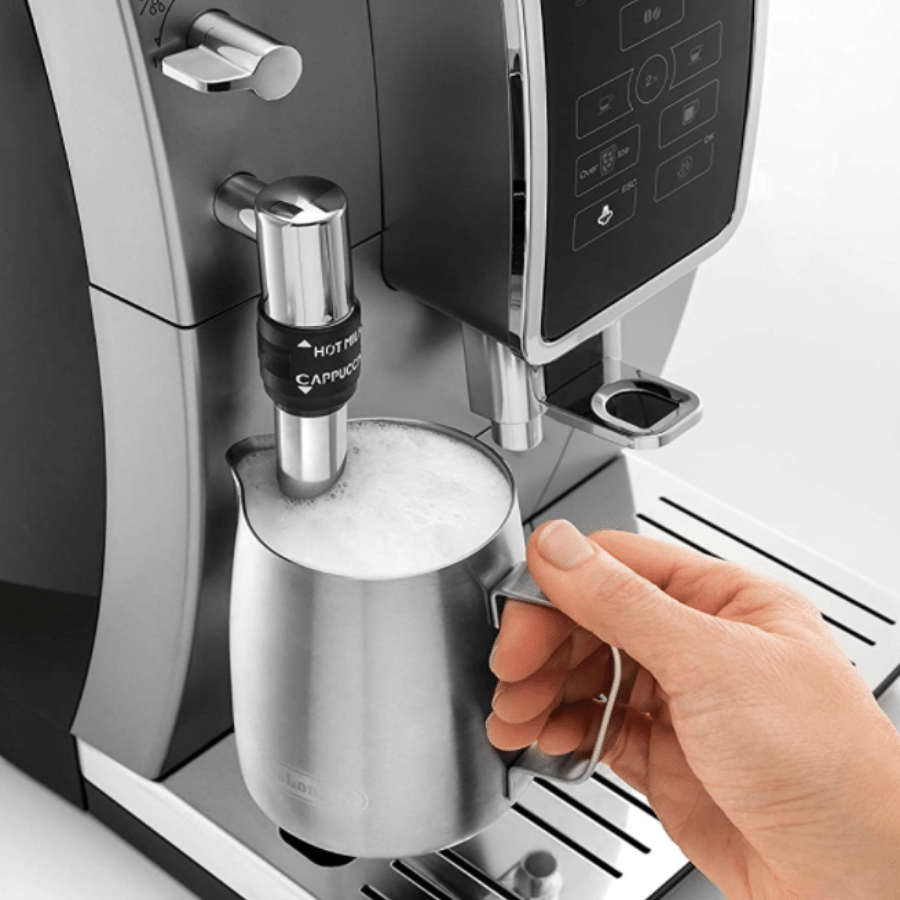
Some DeLonghi’s super-automatic machines, come with integrated milk frothing systems that automatically draw, froth, and dispense milk directly into your cup. You can select your preferred milk-based beverage, and the machine takes care of the entire process.
Value
Breville’s semi-automatic machines offer excellent value and a balance between control and convenience. These machines provide advanced features like customizable grind settings, precise temperature control, and manual milk frothing while also being affordable home machines. Overall, they are a great value for coffee enthusiasts who want to hone their barista skills without breaking the bank.
DeLonghi’s super-automatic espresso machines provide value in terms of convenience. They provide one-touch brewing for a variety of coffee drinks, automated milk frothing, and customization options. They are a great choice for users seeking ease of use and often cost under $1,000, which is actually a value in this category.
DeLonghi offers a wider range of budget options, too. Whether you’re looking for a compact model like the Dedica Arte or a more advanced super-automatic like the Dinamica, there’s a DeLonghi machine for various needs and budgets.
Breville’s lineup is more limited, so there are fewer options in terms of price. However, even machines with automated puck prep, built-in grinders, and powerful manual steam wands are available for under $1,000.
Warranty and Customer Service
Breville typically offers a one-year limited warranty on their espresso machines. This warranty covers defects in materials and workmanship. Breville provides the option to purchase extended warranties for some of their products, which can extend coverage for additional years.
Breville is also known for its responsive customer service and support. They have customer service lines and online resources, such as user manuals and troubleshooting guides.
DeLonghi typically offers a two-year limited warranty on their espresso machines. This is longer than the standard warranty offered by many other brands. The warranty also covers defects in materials and workmanship.
DeLonghi is also known for its customer service and support as well. They have customer support channels that assist users with any questions or issues they encounter with their machines.
Although DeLonghi’s standard warranty covers the machine for longer, both manufacturers offer reliable, high-quality craftsmanship and great customer service when something does go wrong.
Which Is Our Favorite Espresso Machine Brand?
At Craft Coffee Spot, we like both Breville and DeLonghi…for different reasons.
- Breville is a great choice for semi-automatic machines at a good price point.
- DeLonghi is a great choice for super-automatics and budget semi-automatic options.
For more control over the brewing process and slightly better espresso quality, we prefer Breville. For convenience and simplicity, our vote goes to DeLonghi.
Breville vs. DeLonghi Summary
Ultimately, the choice between Breville and DeLonghi will depend on your preferences, skill level, and the specific features you want in an espresso machine. Choose DeLonghi if you want a quality super-automatic that doesn’t break the bank. Go for a Breville espresso machine if you want a semi-automatic espresso machine to learn or perfect your espresso skills.
Congrats! You’re now an expert on all things Breville and DeLonghi espresso machines. The only thing left is to choose the best espresso machine for you. Luckily, we’ve got you covered. Check out our roundup of the best DeLonghi espresso machines and the best Breville espresso machines.

